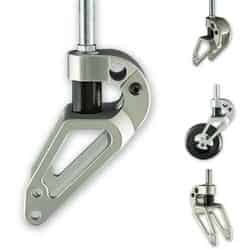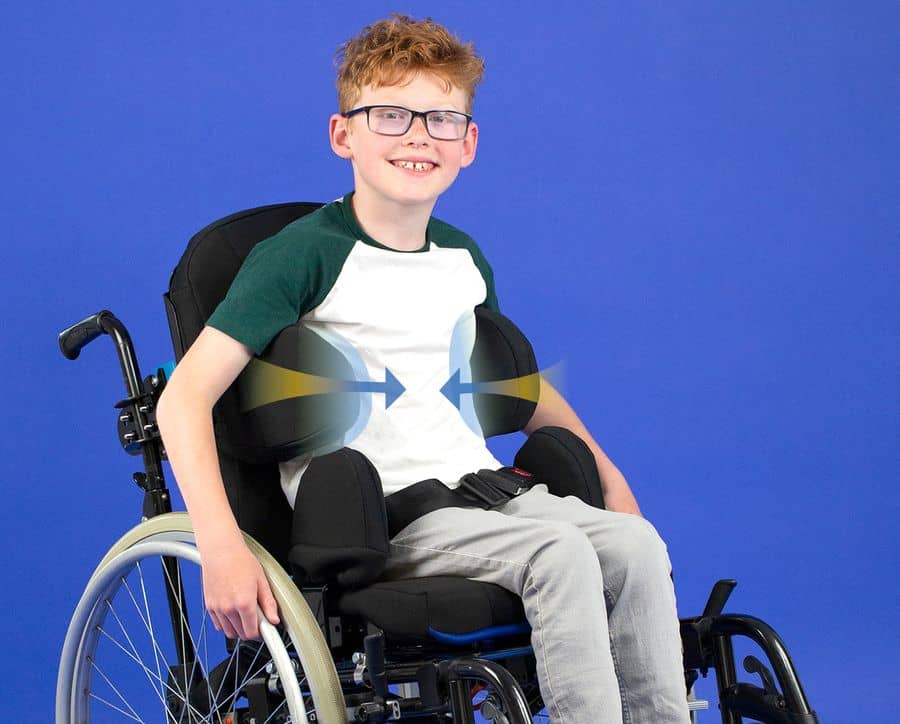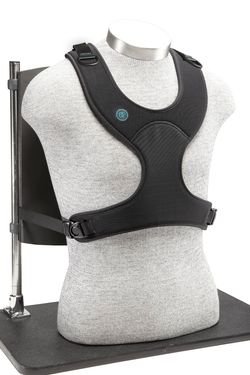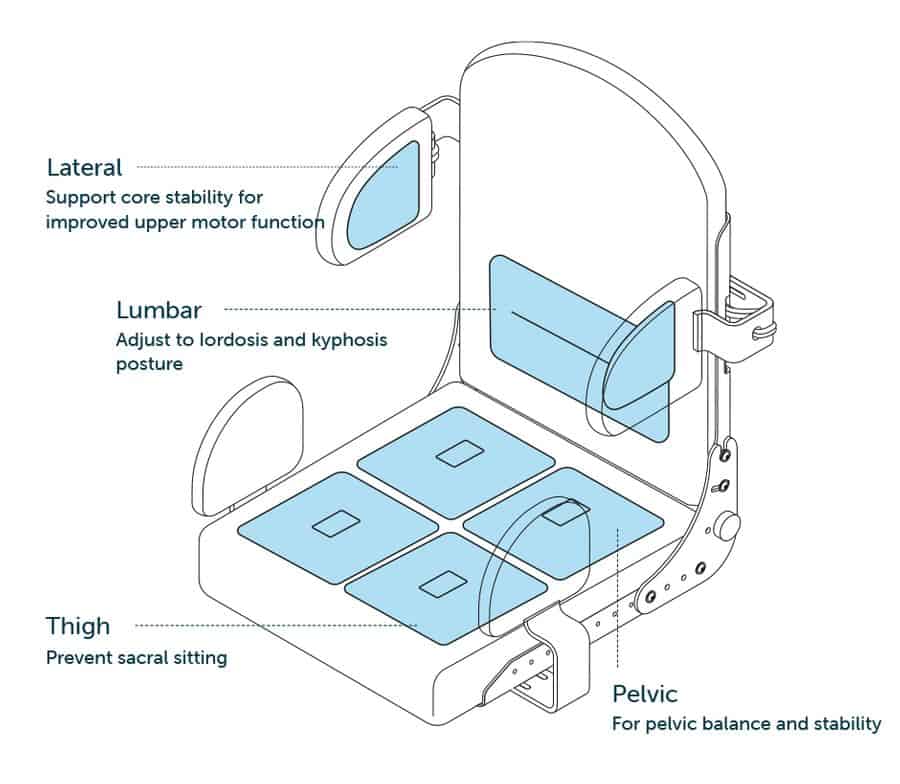Let’s get it clear: Dynamic seating – What does it involve?
Dynamic seating is a term which covers a range of seating applications. Some of these relate to engineering applications to protect the equipment, whereas others have clinical implications. On the clinical side, some applications are passive, and often these are there to ‘protect’ the client, whereas others are active and provide improved functionality for the user. This article highlights why one or more dynamic aspects should be included in the assessment and prescription of a seating system.
Wheelchairs are subject to sources of a varying range of dynamic forces on their components. Many of these can lead to ‘failure’ or damage to these components. These forces may arise from day-to-day use, as the wheelchair passes over obstacles and irregularities in the terrain on which they are used.
Alongside this, many wheelchair users are constantly moving in their seats, often involuntarily – for example due to the nature of their disorder generating athetoid movements – and often to relieve discomfort or pain. Other users make use of movement to increase their functionality, but these also provide additional structural stresses on wheelchair components.
So what can we do to absorb the energy from these movements to protect the wheelchair, while providing, or providing for, dynamic movements which increase the occupant’s health and functionality?
Mechanical compensation

There are various components that come under stress during everyday use of a wheelchair. These include the belts and harnesses which help position the occupant in the chair. The strength of these items performing under one-off forces, and under repeated forces, are tested for within the tests in ISO 16840-31.
It is therefore imperative for the safety of the occupant that only belts and harnesses which pass the ISO 16840-3 tests are used on a chair. Other components at risk are the more rigid items on a chair, such as back supports, foot supports, head rests etc which are affected by the movements of the occupant within the wheelchair, and from the forces involved with running over rough terrain.
The mechanical components most at risk of failure on a wheelchair are the casters. Mhatre et al2 have published a report that showed that 40 per cent of casters failed within a year, and that none in their study lasted more than 2.5 years. They also showed that, where there was planned preventative maintenance and replacement, the incidence of failure dropped significantly.
There is a new standard3 that is being published very shortly that prescribes tests for the durability of casters, the passing of which should give greater assurance to prescribers and users of wheelchairs.
What can be done to absorb these forces and reduce damage to components? Frog Legs Inc4 in the US have developed a suspension system for front casters which absorb the energy encountered by the casters – these also reduce the vibration through the chair, which is a major factor leading to fatigue of the occupant. 80 per cent of the vibration experienced by the user comes from the casters, and Frog Legs reduce this by 76 per cent – both the chair and the occupant benefit.
For other components of the chair, various manufacturers have come up with a variety of spring-loaded mechanisms which absorb the energy from extension spasms and other higher forces on the components.
Passive dynamic assistance
A dynamic component can also be of positive assistance to the wheelchair occupant. The spring loaded devices, as described above, can be used to absorb energies, but on the other hand the springs can work to assist the occupant to readjust their position.
Such devices can also improve proprioceptive input from the receptors located in our joints, as well as provide physiotherapeutic benefits from muscles working against the spring forces.
Likewise, a dynamic anterior shoulder harness allows the occupant to move forward (thereby increasing their functionality), but the elasticity helps bring the individual back to their original position, especially when getting fatigued.
Note, however, that some chest harnesses known as butterfly harnesses have been known to ride up as they are stretched and relaxed, and there are records of people who have been choked to death as a result – this can be prevented by directing the stretch locally around the shoulders, and not through the whole harness.
In addition, it is critical that a pelvic positioning belt is in place and adjusted appropriately, as well.
Active dynamic assistance
A further application under the purlieu of dynamic seating is where sensors in the seating system detect changes over time, and trigger a change in the seating system to accommodate the change. One such case might be where prolonged pressure under the bony parts of the pelvis could be giving a risk of tissue damage in the buttocks.
Another relevant instance is where a person with muscle weakness is starting to slump as a result of fatigue. An example of equipment that can compensate for this is the Aergo seating system5, where inflatable thoracic lateral, lumbar, and seat cushion pads adjust to adapt the client’s posture to accommodate the changes.
Sensory input
Dynamic aspects of a seating system increase sensory input, and this can be applied clinically to increase alertness, decrease agitation, decrease fatigue, and enhance vestibular input, inter alia. Movement stimulates the vestibular apparatus in the middle ear, which can be either calming or arousing depending on the client.
Studies have shown that dynamic seating systems in the classroom lead to improved attention. Some dementia clients become less agitated with an applied rocking movement, while sub-aroused clients became more alert after rocking, and benefitted from associated reduced depression and anxiety.
In this article I have skimmed over the subject(s) of dynamic seating, and there are many aspects of relevance and importance to any, and all, wheelchair users.
For further in-depth information, the relatively recent RESNA position paper on aspects of dynamic seating6 is free to download and is a very valuable read.
References
1. BS ISO 16840-3 Wheelchair seating – Part 3: Determination of static, impact and repetitive load strengths for postural support devices.
2. Mhatre, A et al Community-based wheelchair caster failures call for improvements in quality and increased frequency of preventative maintenance, Spinal Cord 2021
3. ISO FDIS 7176-32 Wheelchairs — Part 32: Standard practice for wheelchair castor durability testing.
6. Lange, ML et al, RESNA position on the application of dynamic seating 2020
Further items can be found at www.beshealthcare.net. If you are interested in receiving further information on the topic, please contact 
Dr Barend ter Haar has been involved in seating and mobility for over 30 years, including lecturing internationally and developing international seating standards.
Click to read more from the ‘Let’s get it clear’ series from Dr Barend ter Haar




